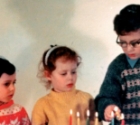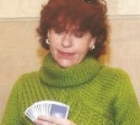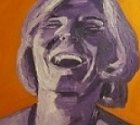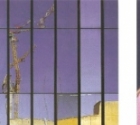
Photo Credit: http://www.flickr.com/photos/sarihuella/4763396814/sizes/z/in/photostream/
Five years ago I was schmoozing with friends who had made aliyah about the same time as I did, 24 years ago. We were talking about how good life was in Tel Aviv, eating fresh and healthy Israeli food, being close to the beach, staying alive, enjoying our old age. But we wondered if there might be something missing. We began to speculate about what it might be. The Chinese game, Mah Jongg, came to mind and with it an image of traditional Jewish matrons at leisure. We looked at one another and suddenly saw on each others' faces the shock of recognition that this was us, this is what we had become, old Jewish women. We laughed out loud and vowed that we would take up the game and fulfill this new self-image.
For me, the word Mah Jongg conjured up a memory of watching my older sister seated at a card table with three friends in her den in Harrisburg, Pennsylvania. I was a bored teenager witnessing four housewives playing Mah Jongg. One would pick a tile from the wall in the center of the table and then discard a tile face up, calling out its name: 4 crack or 7 bam, Flower, Soap, Red Dragon, South Wind, 9 dot. Each woman was intently engaged in the game, placing her tile on her rack, rearranging her hand and checking the card in front of her. Finally, one would declare "Mah Jongg" and reveal her winning hand. The three others sighed in resignation. They proceeded to put all the tiles face down on the table, pushed them around in the center to shuffle them, and then with their manicured hands, each one rebuilt her wall of tiles in front of her rack. The whole thing started all over again.
That afternoon stayed in my memory for more than 50 years. My Tel Aviv friends recalled that their mothers had played the game. None of us knew much about it, but we were resolved to find a way to bring Mah Jongg into our lives. We knew one thing: we needed a Mah Jongg set and decided that we would find some way to acquire one. The next time I visited my family in Lebanon, Pennsylvania, I remembered my resolve to find a set. While it was my sister, Shirley, whom I remembered playing the game, she had died a few years earlier. I was staying at the home of my sister, Isabel. I told her that I had two friends in Tel Aviv and we wanted to take up Mah Jongg. "Where can I get a set?" I asked.
"I have one!" she said. Of course she did. Isabel had everything and she kept everything she had. Most of her stuff was in the basement, so I expected the set would be stored with the things from a time long ago: the pool table, the ping-pong table, the player piano, the giant glass goblet containing her matchbook collection that went back to the 40s, the console record player in the mahogany cabinet that contained the classics from the 40s, songs of Hoagy Carmichael, Glenn Miller, Tex Beneke. But the Mah Jongg set was not among those things from the past.
It was in the closet of the den. Isabel opened the wide folding doors to a closet that contained all the materials required for entertaining: folding chairs, folding card tables, paper plates, napkins and tablecloths and plastic dinnerware. On a high shelf in the closet were the family games: monopoly, checkers, chess, playing cards and Rummikub. She reached up and brought down a handsome brown suitcase with a sturdy handle. She placed the suitcase on the game table in the den. With my thumbs I pressed the buttons at the front of the lid on each side of the case, and two brass hasp locks snapped open with a solid sound. It had the feel and sound of the handles on a vintage sports car, a feel and sound from the past, when things were made to last. I lifted the lid and inside were more than 152 tiles, the color of butterscotch, arranged in two long open boxes. There were plastic racks for each player to set up her tiles, and a pair of dice. The suitcase weighed about 12 pounds, so carrying it back presented another challenge. This was in 2006; luckily it was before airlines began to charge extra for carry-on luggage.
I returned to Tel Aviv triumphant. "I've got the set." How naive I was; I thought all we needed was the set. There was a lot more: we needed at least four people with leisure time who wanted to play, and furthermore, who knew how to play. And we needed a card table. It was then we discovered that there are no folding card tables here in Israel. Anyway, we didn't even know how to play. We opened the suitcase and looked at the beautiful tiles with their colorful markings, the plastic racks and the dice, and we had no idea what to do with them.
A few years went by and still we had no clue about how to play the game. Then we discovered a book: A Beginner's Guide to American Mah Jongg: How to Play the Game and Win, written by Elaine Sandberg, published by Tuttle Publishing. It was first published in 2007 and printed again in 2010. I ordered copies online from Book Depository. The book explained it all, from beginning to end, the steps of the play, the rules and the strategy for winning. Now all we needed was a fourth player. Finally a young woman answered the ad we placed on Tanglo. She had a square table so we brought the set to her apartment. She set aside the superfluous tiles and made stickers for eight jokers. We started to play. It was more fun than we had expected. She had gotten us started but it wasn't long before her job in hi-tech demanded more of her time and she dropped out. We placed another ad. It was answered by a woman who had played the game in Miami before moving to Israel in the 60s. She was experienced and she had a card table! Soon we were playing at her house twice a week. We were addicted.
All was going well until the woman with the square table dropped out. We not only lost a key player, but we again needed a fourth and we also needed a card table. As fate would have it, a couple of card tables turned up in the trash. We picked out the best one and were ready to play if only we could find a fourth player. A young woman answered our ad. She had gotten hooked on the game in the States. She was young and she was a working woman, so we had to meet in the evenings instead of the afternoons.
We have come a long way and now have a small group of dedicated players - too small. We would like to play more often and find more players. Beginners are welcome. We recommend reading the Elaine Sandberg book in order to learn how to play. Anyone interested in joining a Mah Jongg game, mornings, afternoons, or evenings in Ramat Aviv should send an email to <magen@netvision.net.il>.
 Chanukah 5773
Chanukah 5773 The Guild launches its season with The Fantasticks
The Guild launches its season with The Fantasticks My Chanukiah
My Chanukiah Bridge the right way
Bridge the right way A Bit of Humor on Food
A Bit of Humor on Food ESRA Photo enthusiasts meet monthly
ESRA Photo enthusiasts meet monthly